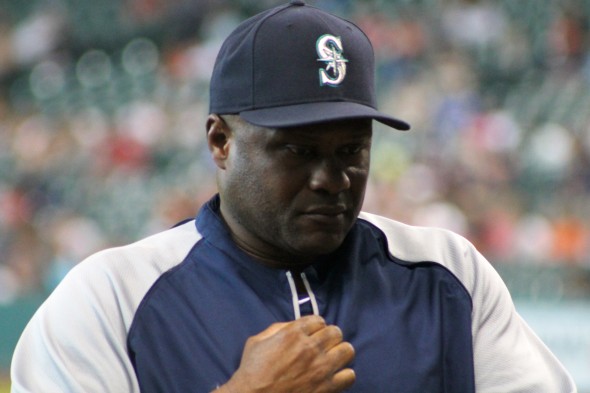
Despite statistical evidence to the contrary, Mariners manager Lloyd McClendon doesn’t buy into the idea that Safeco Field is a poor park for hitters.
“It’s false,” McClendon told reporters Thursday. “I mean that. Go to Comerica (Detroit) if you want to see a big ballpark. It’s 430 (feet to) straightway center and 415 in right-center. Safeco (deepest point of the park is 405 feet) is not a big place.”
Two years ago, in a move many believed long overdue, the Mariners shortened the fences at Safeco Field, bringing them in from four to 17 feet and standardizing the height of the outfield wall at eight feet. This hasn’t exactly been a boon to Seattle hitters.
Last year, the Mariners at home ranked 15th (and last) in the American League in runs (281), hits (619), doubles (105), batting average (.238), on-base percentage (.294) and OPS (.664) and 14th in total bases (965). On a more positive note, they ranked ninth in home runs (73).
But on the road, they ranked fifth in runs (353), seventh in hits (709), ninth in average (.249) and 10th in slugging (.387) and OPS (.687). Had the Mariners put up those numbers at Safeco, they would have made the postseason.
According to McClendon, the anemic numbers are not so much the result of Safeco being a poor hitters park as it is the fact that Seattle has featured poor hitters playing at Safeco, the lightly missed Justin Smoak popping immediately to mind.
“It (Safeco Field) used to be big,” McClendon said. “It’s not big anymore. The fences are in. Washington came in (last year), and made Safeco look real small (10 home runs in a three-game series Aug. 29-31). Nelson Cruz (playing for the Orioles) hit the ball out and made Safeco look real small.”
McClendon had a colorful way of describing Seattle’s poor stats at Safeco.
“It looks big when you’ve got guys that have their puppy muscles. When they get their man muscles, it becomes small. It’ll be small for us now, trust me.”
Mariners 4, Rangers 4
Getting a start at designated hitter, Mike Zunino crushed two home runs in Friday’s 4-4 tie with the Texas Rangers in Surprise, AZ. Zunino ripped a solo shot off Jon Edwards in the fourth inning and a two-run blast off Spencer Patton in the sixth, finishing 2-for-3.
Seattle starter Roenis Elias worked four innings and allowed two runs, including one earned, on five hits, two walks and five strikeouts.
Texas trailed 3-2 in the seventh before Mitch Moreland cracked a two-run homer off Tom Wilhelmsen. The Mariners tied the game in the eighth on a homer by Alex Jackson, Seattle’s 19-year-old 2014 first-round pick out of Rancho Bernado (CA.) High School.
Roster moves
The Mariners Friday sent LHP Lucas Luetge, C John Hicks, INFs Ketel Marte and Jesus Montero and OFs James Jones and Stefen Romero to AAA Tacoma, and assigned RHP Justin Germano, LHP Rafael Perez, INFs D.J. Peterson and Patrick Kivlehan and OF Franklin Gutierrez to their minor league camp.
Notes
Felix Hernandez will pitch Saturday against the Cubs. James Paxton will make his spring debut Sunday against the Rangers in Peoria . . . Hisashi Iwakuma will throw a simulated game Monday against minor leaguers rather than face the AL West rival Angels.
Linkage

4 Comments
I like Mac’s mindset and the optimism but I’m from Missouri on his projection. Show me. Until then, I’ll still consider Safeco Field a pitcher-friendly park where a ball that flies out in the warmer, drier air during day games becomes a warning-track out in the cooler, moister air during night games.
This year’s edition has had a year to learn how to win and they’re showing the kind of confidence winners have. Credit Mac for that…he’s got them believing.
The problem here is the Rod Serling-like Zone of Strange Measurement. Imagine this:
If the Safeco heavy air rains well-hit balls to the warning track, why and how can it be that it doesn’t matter where the warning track IS? ( There was the same exact complaint and reasoning before and after the fences were moved in — no change). Does the heavy air knowingly amass an even-heavier-ness directly over warning track dirt, no matter the location of the warning track or distance from Home Plate? And that Twilight Zone characteristic of zone defense heavier-ness therefore shoves well-hit balls face-plant downward to the warning track dirt no matter where the fences are placed? Or does Safeco Warning track dirt have undetectable Twilight Zone leather magnets of the strength that would power a dozen Dick Tracy transporters that suck well hit balls to the track?
Or, maybe, just maybe, have the M’s been crippled under bad-judgement execs that couldn’t find and sign a reliable 3,4,5, hitter lineup for about 2 decades?
I’m guessing the air and distance from home plate is pretty much exactly as expected and balls stay in the yard because they haven’t been hit hard. By the M’s. Lloyd is right. Distance and humidity in Seattle are on the micro centonn scale compared to Detroit. You could measure both. These guys will hit em hard.
This has NEVER been about Safeco Field. It has ALWAYS been about the impotence of Mariners “hitters.” You notice opposing teams never seem to have a problem crushing the ball here, day or night.
Edgar hit well at Safeco. So did Ichiro. It’s a matter of using the park and not trying to beat it. It stands to reason if everyone can get on base someone will score. But players still try to hit for power at Safeco and complain later on. Yes, it’s a pitchers park but that means what works at Tropicana will have to be shelved for a different gameplan. Over the years M’s players seem to be in denial of that.